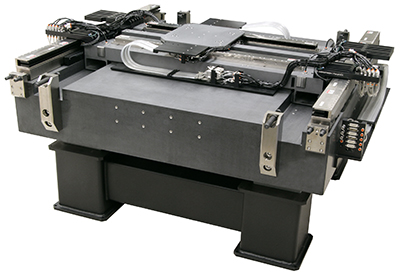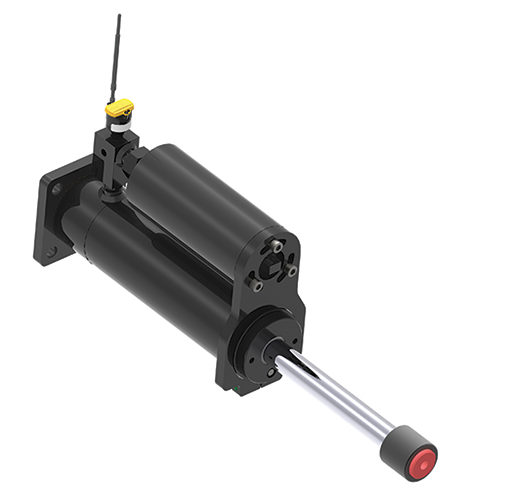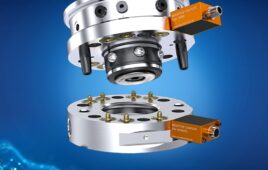The move to faster speeds, larger volumes and greater outputs in automated machinery is prompting more use of vibration and shock mitigation technologies. This has intensified innovations to shock absorbers, vibration dampers, air bearings and other devices, which run the gamut from faster response-designs to smart technologies.
According to Brian Fink, Product Manager, Aerotech Inc., “Optimizing a motion system’s move-and-settle performance is key to improving throughput in high-volume, high-precision manufacturing applications. As the motion system aggressively accelerates and decelerates, the applied forces react against the machine base. This results in an oscillation that can last for hundreds of milliseconds or longer during which the processing must be delayed until the oscillation attenuates in order to maintain the required accuracy.”

Aerotech’s PlanarHDX two-axis, planar air-bearing stage features a reaction-mass design that significantly reduces forces imparted to the machine base, thereby enabling lighting-fast turnaround and move-and-settle times.
Fink described one of Aerotech’s mechanical options — its PlanarHDX, a two-axis, planar air-bearing stage, which features a reaction-mass design that significantly reduces forces imparted to the machine base, thereby enabling lighting-fast turnaround and move-and-settle times. Additionally, from a control systems standpoint, Aerotech offers an Enhanced Throughput Module (ETM), a mechatronic solution that measures the unwanted motion of the machine base and feeds it back into Aerotech’s motion controller, which then alters the commanded motor currents to effectively isolate the moving workpoint from the base motion.
“With these advanced vibration-mitigation technologies, Aerotech can transform your high-throughput process to be fast, accurate, and affordable,” Fink said.
Greg Herman, Director of Sales & Business Development, ITT Enidine, said that as more customers look to get more output from their existing equipment, the operating speed of the equipment must increase, which in turn generates more energy in the system. This energy is damaging not only to the equipment, but also the product or process being produced. With more energy in the system, managing this energy becomes critical.
“One such customer currently using our products had increased the cycle rate of their equipment (speed) by more than 40%. For a short time, the customer was happy with the production of the equipment. However, it became clear that the energy absorption product that was in the system was not adequate for the increased speed, force and energy generated by the equipment,” Herman said.
“After reviewing the applications changes with us, we were able to size the appropriate product which has accomplished the goal of the customer — increased production.”
Scott McNeil, Engineering Director, ACE Controls Inc., agreed that the trend to faster production continues. “That is the original driver of our business. The original reason for the first industrial shock absorber was that it allowed line speeds to increase, reduced damage and extended equipment life,” McNeil said. “An example of products that increase production are our high performance PET shocks for the plastic bottle industry, which allow manufacturers to speed up production over the original equipment shocks.”
Enabling IoT functionality for dampers and more
In addition, ACE Controls recently launched a smart shock absorber to enhance accuracy and improve system output and speed.
“Our smart shock absorbers will reduce downtime as they and the equipment they are installed in can be maintained using predictive and prescriptive maintenance procedures,” McNeil said. “We have recently demonstrated our IoT capabilities at the ATX Trade Show in Anaheim, Calif. this year, showing our smart shock absorber solution.”
ACE’s IoT-enabled shock absorber uses an Intel NuC Edge computing device and wireless sensors for data acquisition. Edge computing enables optimization of the quantity of data sent to the cloud and also performs real-time monitoring in the field. It does this by collecting sensor data in the edge layer in the field and by processing and analyzing the data. This can avoid the concentration of processing operations in the cloud layer so that the IT resources in the cloud layer can be optimized and their availability improved.

ACE Controls fitted its shock absorber technology with an IoT sensor to allow for simpler predictive maintenance.
“We are currently using the Bluetooth 5.0 communication protocol with the capability to use other protocols such as LoRa, eSIM, etc. Our current system can process up to 200 sensor nodes for real time performance monitoring. Apart from performing a run time computation using the edge computer we also have the data stored in a secured cloud database for pattern analytics,” McNeil said.
Rahul Chandrashekar, Software System Architect, ACE Controls Inc., added that the hardware ACE is using for its IoT capabilities uses an Intel core i7 with Ubuntu operating system. “The system has a small footprint with a form factor of 100 x 100 mm and has the memory capacity of 32 GB. A small footprint on both the physical size and memory helps keep the cost of hardware economical,” Chandrashekar said.
McNeil concluded by adding that using industry standard communication protocols like Bluetooth and LoRa is critical to the successful implementation of its technology. “We know that a company of our size has to match the market trend. We strive for plug-and-play as much as possible. We are also using industry standard sensors and such for the same reasons and to piggyback off the validation and use cases of the suppliers of these products. We also follow trends like a recent National Fluid Power Association (NFPA) survey regarding IoT where we felt we were very well aligned.
“When working on new designs we try to maintain the relationship with our current products so we don’t create redundancy and overlap. We try to take the best of all that we have learned and incorporate it into new products,” McNeil said.
The future and beyond for shock absorbers
Automation in agriculture will continue to offer huge growth for the use of shock and vibration damping technologies. For example, as cannabis grows in legal use across the nation, so too will faster ways to produce it.
Chris Niemiec, Engineering Manager, ACE Controls Inc., said that cannabis operations already utilize ACE’s shock absorbers in their trimming machines today. “We expect more and more opportunities in this rapidly growing market. Additionally our products cater to all sorts of automation in the agricultural industry,” Niemiec said. “One example is automatic strawberry pickers that are designed to pick the strawberries at a high rate, yet not bruise them.”
Additionally, based on ACE’s study of the technology trend toward wireless connectivity, the company is focusing on requirements such as how to connect the battery, how to operate low cost assets (sensors), outdoor and harsh environments, low cost communication, low cost infrastructure, low power technology, robust communication, mobility and scalability.
“Trends for wireless communication choices could be based on trade-offs between autonomy and range of connectivity. Communication between end devices and gateways is spread out on different frequency channels and data rates. The selection of the data rate is a trade-off between communication range and message duration,” said Chandrashekar.
“Due to the spread spectrum technology, communications with different data rates do not interfere with each other and create a set of “virtual” channels increasing the capacity of the gateway. LoRaWAN data rates range from 0.3 to 50 kbps. To maximize both battery life of the end devices and overall network capacity, the LoRaWAN network server is managing the data rate and RF output for each end device individually by each end-device individually by means of an adaptive data rate (ADR) scheme.”
You may also like:
Filed Under: Cannabis, MOTION CONTROL, Shocks + vibration control • gas springs







